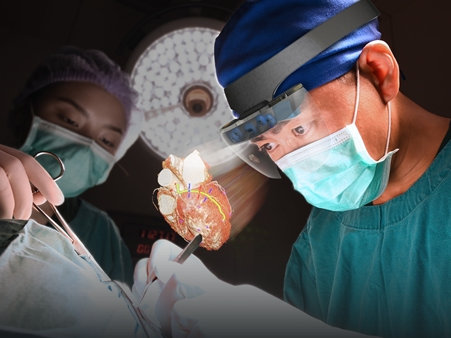Ocutrx Vision Technologies, LLC, a technology startup developing an augmented reality headset, has announced the successful preliminary results of its Dynamic Opacity outer lens in providing safety for surgeons and operating room technicians using medical lasers. Used on the ORLenz Augmented Reality (AR) Surgery Visualization headsets, and designed to be combined with surgical digital microscopes feeds and laser technologies for treatment of conditions in the eye, the ORLenz AR headset is set to provide surgeons with enhanced surgery visualization, ease, comfort and safety.

Image credit: Ocutrx Vision Technologies
Medical lasers, including ophthalmic lasers, provide precise treatment for a range of eye conditions with little risk of infection – and are usually a less invasive option. The combination of safety, accuracy and relative low cost makes lasers useful ophthalmic tools for surgeries such as a posterior capsulotomy. Ophthalmic lasers are used with patients who have previously had cataract surgery then present with subsequent cloudy vision due to clouding of the posterior capsule. A surgeon uses a laser to painlessly clear the vision again. Other ophthalmic laser uses include treatment of glaucoma, diabetic retinopathy, vein occlusions, retinal holes and retinal detachments.
When medical lasers are used, there exists a nominal hazard zone (NHZ) in an operating room, where personnel must adhere to appropriate eye protection procedures during all laser applications. Appropriate laser protective eyewear (LPE) must be worn by everyone in the NHZ while the laser is in operation. Appropriate LPE typically currently consists of glasses or goggles of sufficient optical density (OD) to prevent ocular injury at the laser wavelength in use. Surgeons looking through a microscope which has a lens filter for the laser in use are typically exempt, but not with the advent of new “head’s-up” tv monitor surgery systems this often also includes the surgeon who must wear protection. This means a surgeon may have to hold the laser while a tech removes his 3D glasses and puts on goggles, all while the surgeon is holding the place to laser.
“Developing an entirely new 3D holographic display for the OR brings its challenges and opportunities,” said Michael H. Freeman, CEO/CTO of Ocutrx. “The opportunity here is to have our ORLenz headset double as the safety protection for laser surgery. In this way, surgeons, assistants, techs and others in the OR NHZ wearing the ORLenz do not have to wear googles because the Dynamic Opacity lens features serves to safely block harmful laser photons and wavelengths.
Ocutrx’s patent pending Dynamic Opacity layer contains cholesteric liquid crystals on the outer lens which creates a “shadow” opaqueness that exactly (1:1) mirrors the image being projected onto the reflective inner lens. In this way, the ORLenz can be up to 85 percent see-through so very little ambient lights has to be blocked, whereas other AR headsets must block up to 85 percent of ambient light to see the AR image. Unlike other liquid crystal technologies, the Ocutrx Dynamic Opacity is characterized as bistable because their liquid crystals do not need power to maintain a selected state. This is not true of LCDs or LEDs because LCDs need constant power. Also, LCD’s, because they use polarization, can only be 50 percent see-through, while cholesteric liquid crystals provide almost 100 percent see-through.
Tests conducted at the Ocutrx testing facility in Colorado Springs, Colorado, show that the liquid crystals hold significant promise in blocking and attenuating photons emitted by medical lasers. Current tests show blocking of almost 70 percent of direct laser hit with reflection and diffusion of the intensity of the laser beam with just a few crystals. Improvements on the crystal layers resolution and wave filtration are expected by the end of 2020.
“Major Healthcare industry leaders have expressed excitement and optimism about how our AR surgery visualization headset can improve existing operating room platforms,” said Michael H. Freeman, CEO/CTO of Ocutrx. “We have just begun our testing of a liquid crystal design for laser protection and these results show that our Dynamic Opacity can play a major role in OR laser safety, eliminating one cumbersome existing step of putting on and off goggles in the OR.”
With a large field of view of 120 degrees (100 degrees horizontal and 45 degrees vertical), the ORLenz accepts a single or dual 4K microscope feed, providing 3D visualization for operating room care. Surgeons not only see the microscope images with 60 pixel-per-degree resolution (the highest resolution the human eye discern at 20/20) but can further magnify the digital microscope images up to 10 times in the headset.
